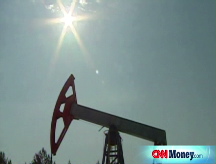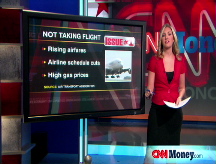Oil: Biggest drop in 17 years
Crude prices fall by largest dollar amount since 1991 as investors fear the decline in U.S. demand could spread overseas as Europe's economies slow.

NEW YORK (CNNMoney.com) -- Oil prices plummeted Friday, erasing the previous session's spike, as the dollar strengthened and investors worried that a decline in demand will spread outside the United States.
U.S. crude for October delivery dropped $6.59 to settle at $114.59 a barrel on the New York Mercantile Exchange.
The drop in oil was the largest single-day slide in dollar terms since Jan. 17, 1991, when oil fell by $10.56. On that day, President George H.W. Bush withdrew oil from the Strategic Petroleum Reserve ahead of the first Gulf War.
But in 1991, oil was trading at just $32 a barrel, so the more than $10 slide in dollar terms represented a record 33% drop. Oil fell 5.4% Tuesday, which does not even crack the top 50 price declines in percentage terms.
Oil's second-largest slide on Friday comes a day after the second-largest gain on record. Crude futures soared $5.62 a barrel Thursday to rise above $121 a barrel.
"We're trending towards a lot of oil price volatility on the direction of the dollar," said Peter Beutel, an oil analyst with Cameron Hanover. "There are huge amounts of money involved, and the large moves have been based primarily on dollar strength."
Dollar rebounds: The dollar rose after a key measurement showed British economic growth stalled in the second quarter.
The U.K.'s gross domestic product between April and June showed zero growth, the country's statistics office reported Friday.
The economic weakness in Britain signaled that falling demand for oil due to high fuel prices could spread to Europe, according to Kyle Cooper, director of research with IAF Advisors in Houston.
"Fewer trucks delivering packages, fewer people going to work ... There's a very strong correlation between GDP growth and oil usage," said Cooper.
The U.K. report follows other reports this week showing weakness in the euro zone and Japanese economies, putting U.S. investment - and the dollar - in a more favorable light.
A stronger dollar makes crude more expensive for foreign investors, because crude futures are traded in U.S. currency. Rising dollar values also pull investor money out of oil, since many use crude and other commodities as a hedge against inflation.
Georgia-Russia: Oil rose Thursday on tensions between NATO and Russia over the nation's occupation of Georgia. Georgia contains several vital pipeline links that carry crude oil and natural gas between Europe and Asia.
But those tensions appeared to ease Friday.
"There was the potential for some type of action across the Georgian border and we just haven't seen anything," said Neal Dingmann, senior energy analyst with Dahlman Rose & Co.
Also easing supply worries, a BP-led consortium prepared to resume oil flow through the region's Baku-Tbilisi-Ceyhan pipeline, a major oil link between Turkey and the Caspian Sea.
"We're still integrity testing," said BP spokesman Toby Odone, "We expect it will be back in normal operation next week."
U.S. gasoline demand: Falling demand for petroleum-based fuels in the United States has been the main force behind oil's fall from a record high of $147.27 in mid-July.
Demand for gasoline last week was about 9.5 million barrels a day, or 1.6% lower than it was last year, according to an Energy Department inventory report released Wednesday.
Drivers were also spending less time on the road in June, according to a second report from the Transportation Department last week.
Drivers will even cut back over the Labor Day weekend, according to a projection from motorist group AAA. The number of travelers avoiding cars and air travel, and using buses, trains, or other transportation will increase by 12.5% this year, AAA said.
National gasoline prices are down more than 42 cents a gallon from the record high set last month, according to the AAA's daily survey of service stations, falling below $3.70 a gallon. ![]()








